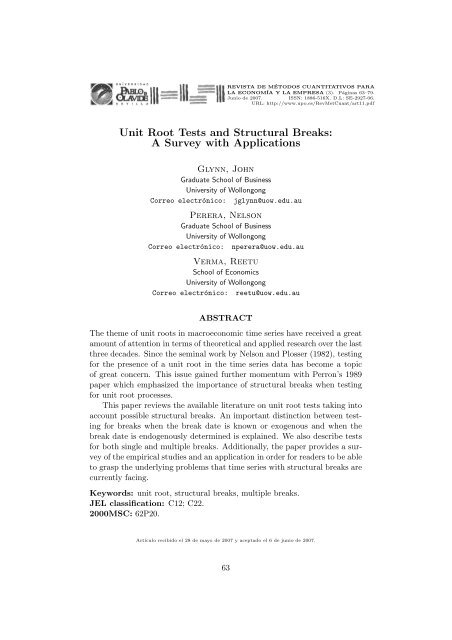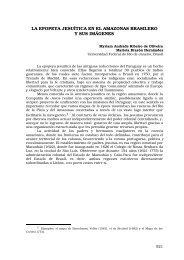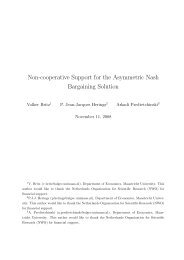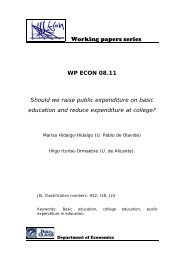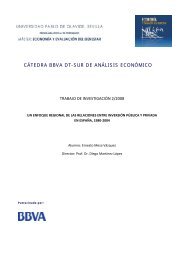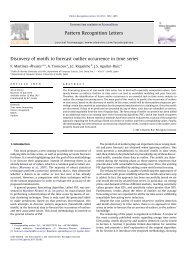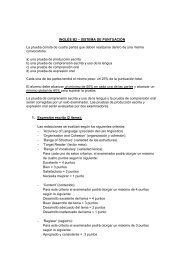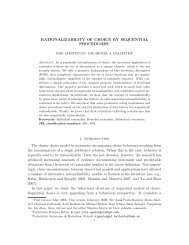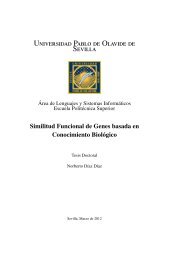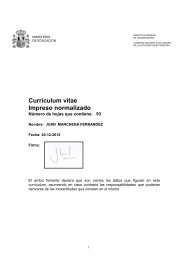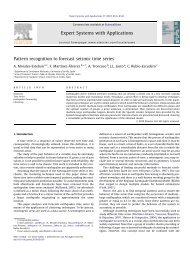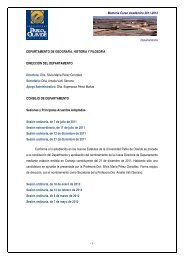Unit Root Tests and Structural Breaks: A Survey with Applications
Unit Root Tests and Structural Breaks: A Survey with Applications
Unit Root Tests and Structural Breaks: A Survey with Applications
You also want an ePaper? Increase the reach of your titles
YUMPU automatically turns print PDFs into web optimized ePapers that Google loves.
REVISTA DE MÉTODOS CUANTITATIVOS PARA<br />
LA ECONOMÍA Y LA EMPRESA (3). Páginas 63–79.<br />
Junio de 2007. ISSN: 1886-516X. D.L: SE-2927-06.<br />
URL: http://www.upo.es/RevMetCuant/art11.pdf<br />
<strong>Unit</strong> <strong>Root</strong> <strong>Tests</strong> <strong>and</strong> <strong>Structural</strong> <strong>Breaks</strong>:<br />
A <strong>Survey</strong> <strong>with</strong> <strong>Applications</strong><br />
Glynn, John<br />
Graduate School of Business<br />
University of Wollongong<br />
Correo electrónico: jglynn@uow.edu.au<br />
Perera, Nelson<br />
Graduate School of Business<br />
University of Wollongong<br />
Correo electrónico: nperera@uow.edu.au<br />
Verma, Reetu<br />
School of Economics<br />
University of Wollongong<br />
Correo electrónico: reetu@uow.edu.au<br />
ABSTRACT<br />
The theme of unit roots in macroeconomic time series have received a great<br />
amount of attention in terms of theoretical <strong>and</strong> applied research over the last<br />
three decades. Since the seminal work by Nelson <strong>and</strong> Plosser (1982), testing<br />
for the presence of a unit root in the time series data has become a topic<br />
of great concern. This issue gained further momentum <strong>with</strong> Perron’s 1989<br />
paper which emphasized the importance of structural breaks when testing<br />
for unit root processes.<br />
This paper reviews the available literature on unit root tests taking into<br />
account possible structural breaks. An important distinction between testing<br />
for breaks when the break date is known or exogenous <strong>and</strong> when the<br />
break date is endogenously determined is explained. We also describe tests<br />
for both single <strong>and</strong> multiple breaks. Additionally, the paper provides a survey<br />
of the empirical studies <strong>and</strong> an application in order for readers to be able<br />
to grasp the underlying problems that time series <strong>with</strong> structural breaks are<br />
currently facing.<br />
Keywords: unit root, structural breaks, multiple breaks.<br />
JEL classification: C12; C22.<br />
2000MSC: 62P20.<br />
Artículo recibido el 28 de mayo de 2007 y aceptado el 6 de junio de 2007.<br />
63
Contrastes de raíces unitarias<br />
y cambios estructurales:<br />
un estudio con aplicaciones<br />
RESUMEN<br />
El tema de las raíces unitarias en series temporales macroeconómicas ha<br />
recibido gran atención, tanto desde el punto de vista teórico como de investigación<br />
aplicada, en las últimas tres décadas. Desde el trabajo clave<br />
de Nelson y Plosser (1982), contrastar la presencia de una raíz en datos<br />
temporales ha llegado a ser un asunto de gran interés. Esta cuestión ganó<br />
incluso preponderancia con el artículo de Perron de 1989, que destaca la<br />
importancia de los cambios estructurales al contrastar procesos de raíces<br />
unitarias.<br />
Este trabajo revisa la literatura disponible sobre contrastes de raíces<br />
unitarias, teniendo en cuenta los posibles cambios estructurales. Se explica<br />
la diferencia entre contrastar cambios cu<strong>and</strong>o la fecha del cambio es<br />
conocida (o exógena) y cu<strong>and</strong>o el cambio es determinado endógenamente.<br />
También describimos contrastes tanto para cambios simples como para cambios<br />
múltiples. Además,elartículo revisa los estudios empíricos y da una<br />
aplicación para que los lectores puedan comprender los problemas subyacentes<br />
que se están afront<strong>and</strong>o en el estudio de las series temporales con<br />
cambios estructurales.<br />
Palabras clave: raíces unitarias; cambios estructurales; cambios múltiples.<br />
Clasificación JEL: C12; C22.<br />
2000MSC: 62P20.<br />
64
1. Introduction<br />
During the last three decades, the methods of estimation of economic<br />
relationships <strong>and</strong> modeling fluctuations in economic activity have been subjected to<br />
fundamental changes. The method of estimation of the st<strong>and</strong>ard regression model,<br />
Ordinary Least Square (OLS) method, is based on the assumption that the means <strong>and</strong><br />
variances of these variables being tested are constant over the time. Variables whose<br />
means <strong>and</strong> variances change over time are known as non-stationary or unit root<br />
variables. Therefore, incorporating non-stationary or unit root variables in estimating<br />
the regression equations using OLS method give misleading inferences. Instead, if<br />
variables are non-stationary, the estimation of long-run relationship between those<br />
variables should be based on the cointegration method. Since the testing of the unit<br />
roots of a series is a precondition to the existence of cointegration relationship,<br />
originally, the Augmented Dickey-Fuller (1979) test was widely used to test for<br />
stationarity. However, Perron (1989) showed that failure to allow for an existing<br />
break 1 leads to a bias that reduces the ability to reject a false unit root null hypothesis.<br />
To overcome this, Perron proposed allowing for a known or exogenous structural<br />
break in the Augmented Dickey-Fuller (ADF) tests. Following this development,<br />
many authors including, Zivot <strong>and</strong> Andrews (1992) <strong>and</strong> Perron (1997) proposed<br />
determining the break point ‘endogenously’ from the data. Lumsdaine <strong>and</strong> Papell<br />
(1997) extended the Zivot <strong>and</strong> Andrews (1992) model to accommodate two structural<br />
breaks. However, these endogenous tests were criticized for their treatment of breaks<br />
under the null hypothesis. Given the breaks were absent under the null hypothesis of<br />
unit root there may be tendency for these tests to suggest evidence of stationarity <strong>with</strong><br />
breaks (Lee <strong>and</strong> Strazicich, 2003). Lee <strong>and</strong> Strazicich (2003) propose a two break<br />
minimum Lagrange Multiplier (LM) unit root test in which the alternative hypothesis<br />
unambiguously implies the series is trend stationary.<br />
The objective of the paper is to survey the recent development of unit root<br />
hypotheses in the presence of structural change at the unknown time of the break. The<br />
salient feature of the paper is to propose a treatment of this important topic in a non<br />
technical way. The structure for the rest of paper is as follows. Section 2 discusses the<br />
conventional unit roots tests, which do not take into account structural breaks. Section<br />
1 This may be the change in the series as a result some unique economic events.<br />
65
3 explains the unit root testing that takes into account one structural break. <strong>Unit</strong> root<br />
testing that takes into account multiple structural breaks are presented in Section 4. In<br />
section 5, the authors review some empirical studies <strong>and</strong> demonstrate the application<br />
of the techniques presented in the previous sections. Finally, in section 6, the authors<br />
present some concluding remarks.<br />
2. Traditional <strong>Unit</strong> <strong>Root</strong> <strong>Tests</strong><br />
Nelson <strong>and</strong> Plosser (1982) argue that almost all macroeconomic time series<br />
one typically uses have a unit root. The presence or absence of unit roots helps to<br />
identify some features of the underlying data generating process of a series. In the<br />
absence of unit root (stationary), the series fluctuates around a constant long-run mean<br />
<strong>and</strong> implies that the series has a finite variance which does not depend on time. On the<br />
other h<strong>and</strong>, non-stationary series have no tendency to return to long-run deterministic<br />
path <strong>and</strong> the variance of the series is time dependent. Non-stationary series suffer<br />
permanent effects from r<strong>and</strong>om shocks <strong>and</strong> thus the series follow a r<strong>and</strong>om walk.<br />
If the series is non-stationary <strong>and</strong> the first difference of the series is stationary,<br />
the series contains a unit root. The commonly used methods to test for the presence of<br />
unit roots are the Augmented Dickey-Fuller (ADF) tests (Dickey <strong>and</strong> Fuller, 1979 <strong>and</strong><br />
1981). The main thrust of the unit root literature concentrates on whether time series<br />
are affected by transitory or permanent shocks. This can be tested by the ADF model,<br />
which is primarily concerned <strong>with</strong> the estimate ofα . In the following equation, we<br />
test the null hypothesis of α = 0 against the alternative hypothesis of α < 0:<br />
k<br />
∆yt = u + β t + αyt<br />
−1 + ∑c i∆y<br />
t−1<br />
+ ε t<br />
i=<br />
1<br />
(1)<br />
where ∆ denotes the first difference, y t is the time series being tested, t is the time<br />
trend variable, <strong>and</strong> k is the number of lags which are added to the model to ensure that<br />
the residuals, ε t are white noise 2 . Schwarz Bayesian Criterion (SBC) <strong>and</strong> Akaike<br />
Information Criterion (AIC) are used to determine the optimal lag length or k. Nonrejection<br />
of the null hypothesis implies that the series is non-stationary; whereas the<br />
rejection of the null indicates the time series is stationary.<br />
2<br />
This means ε t has zero mean <strong>and</strong> constant variance that is uncorrelated <strong>with</strong> ε s for t ≠ s .<br />
66
3. <strong>Unit</strong> <strong>Root</strong> <strong>Tests</strong> in the presence of <strong>Structural</strong> Break<br />
The debate on unit root hypothesis underwent renewed interest following the<br />
important findings of Nelson <strong>and</strong> Plosser (1982). The traditional view of the unit root<br />
hypothesis was that the current shocks only have a temporary effect <strong>and</strong> the long-run<br />
movement in the series is unaltered by such shocks. The most important implication<br />
under the unit root hypothesis sparked by Nelson <strong>and</strong> Plosser (1982) is that the<br />
r<strong>and</strong>om shocks have permanent effects on the long-run level of macroeconomics; that<br />
is the fluctuations are not transitory.<br />
These findings were challenged by Perron (1989), who argues that in the<br />
presence of a structural break, the st<strong>and</strong>ard ADF tests are biased towards the nonrejection<br />
of the null hypothesis. Perron argues that most macroeconomic series are not<br />
characterized by a unit root but rather that persistence arises only from large <strong>and</strong><br />
infrequent shocks, <strong>and</strong> that the economy returns to deterministic trend after small <strong>and</strong><br />
frequent shocks. According to Perron, ‘Most macroeconomic time series are not<br />
characterized by the presence of a unit root. Fluctuations are indeed stationary around<br />
a deterministic trend function. The only ‘shocks’ which have had persistent effects are<br />
the 1929 crash <strong>and</strong> the 1973 oil price shock’ (1989, pp.1361).<br />
Perron’s (1989) procedure is characterized by a single exogenous (known) break<br />
in accordance <strong>with</strong> the underlying asymptotic distribution theory. Perron uses a modified<br />
Dickey-Fuller (DF) unit root tests that includes dummy variables to account for one known,<br />
or exogenous structural break. The break point of the trend function is fixed (exogenous) <strong>and</strong><br />
chosen independently of the data. Perron’s (1989) unit root tests allows for a break under<br />
both the null <strong>and</strong> alternative hypothesis. These tests have less power than the st<strong>and</strong>ard DF<br />
type test when there is no break. However, Perron (2005) points out that they have a correct<br />
size asymptotically <strong>and</strong> is consistent whether there is a break or not. Moreover, they are<br />
invariant to the break parameters <strong>and</strong> thus their performance does not depend on the<br />
magnitude of the break.<br />
Based on Perron (1989), the following three equations are estimated to test for<br />
the unit root. The equations take into account the existence of three kinds of structural<br />
breaks: a ‘crash’ model (2) which allows for a break in the level (or intercept) of<br />
series; a ‘changing growth’ model (3), which allows for a break in the slope (or the<br />
67
ate of growth); <strong>and</strong> lastly one that allows both effects to occur simultaneously, i.e one<br />
time change in both the level <strong>and</strong> the slope of the series (4).<br />
t =<br />
p<br />
0 + α1DU<br />
t + d(<br />
DTB)<br />
t + βt<br />
+ ρxt<br />
−1 + ∑φi ∆xt<br />
−1<br />
i=<br />
1<br />
x α + e<br />
(2)<br />
t =<br />
p<br />
0 + γDTt<br />
* + βt<br />
+ ρxt<br />
−1 + ∑φi ∆xt<br />
−1<br />
i=<br />
1<br />
x α + e<br />
(3)<br />
t =<br />
p<br />
0 + α1DU<br />
t + d(<br />
DTB)<br />
t + γDTt<br />
+ βt<br />
+ ρxt<br />
−1 + ∑φi ∆xt<br />
−1<br />
i=<br />
1<br />
x α + e (4)<br />
Where the intercept dummy DUt represents a change in the level; DUt =1 if (t > TB) <strong>and</strong><br />
zero otherwise; the slope dummy DTt (also DTt*) represents a change in the slope of the<br />
trend function; DT* = t-TB (or DTt *= t if t > TB) <strong>and</strong> zero otherwise; the crash dummy<br />
(DTB) = 1 if t = TB +1, <strong>and</strong> zero otherwise; <strong>and</strong> TB is the break date. Each of the three models<br />
has a unit root <strong>with</strong> a break under the null hypothesis, as the dummy variables are incorporated in<br />
the regression under the null. The alternative hypothesis is a broken trend stationary process.<br />
However, Perron’s known assumption of the break date was criticized, most<br />
notably by Christiano (1992) as ‘data mining’. Christiano argues that the data based<br />
procedures are typically used to determine the most likely location of the break <strong>and</strong><br />
this approach invalidates the distribution theory underlying conventional testing.<br />
Since then, several studies have developed using different methodologies for<br />
endogenously determining the break date. Some of these include Banerjee,<br />
Lumisdaine <strong>and</strong> Stock (1992), Zivot <strong>and</strong> Andrews (1992), Perron <strong>and</strong> Vogelsang<br />
(1992), Perron (1997) <strong>and</strong> Lumsdaine <strong>and</strong> Papell (1998). These studies have shown that<br />
bias in the usual unit root tests can be reduced by endogenously determining the time of<br />
structural breaks.<br />
Zivot <strong>and</strong> Andrews (1992) endogenous structural break test is a sequential test<br />
which utilizes the full sample <strong>and</strong> uses a different dummy variable for each possible<br />
break date. The break date is selected where the t-statistic from the ADF test of unit<br />
root is at a minimum (most negative). Consequently a break date will be chosen where<br />
the evidence is least favorable for the unit root null. The critical values in Zivot <strong>and</strong><br />
Andrews (1992) are different to the critical values in Perron (1989). The difference is<br />
due to that the selecting of the time of the break is treated as the outcome of an<br />
estimation procedure, rather than predetermined exogenously.<br />
68<br />
t<br />
t<br />
t
Even though Banerjee, Lumisdaine <strong>and</strong> Stock (1992) use endogenous<br />
structural break test, the tests are rolling <strong>and</strong> recursive tests. The numbers of breaks<br />
are determined by non-sequential tests which use sub-samples. This can be viewed as<br />
not having used the full information set, which may have implications for the power<br />
of these tests.<br />
This work was extended by Perron <strong>and</strong> Vogelsang (1992) <strong>and</strong> Perron (1997)<br />
who proposed a class of test statistics that allows for two different forms of<br />
structural break. These are the Additive Outlier (AO) <strong>and</strong> Innovational Outlier (IO)<br />
models. The AO model allows for a sudden change in mean (crash model) while the<br />
IO model allows for more gradual changes. Perron <strong>and</strong> Vogelsang (1992, pp.303)<br />
argue that these tests are based on the minimal value of t statistics on the sum of the<br />
autoregressive coefficients over all possible breakpoints in the appropriate<br />
autoregression. While Perron (1997, pp. 356), argues that "if one can still reject the unit<br />
root hypothesis under such a scenario it must be the case it would be rejected under a<br />
under a less stringent assumption". Perron <strong>and</strong> Vogelsang (1992) applied these two models<br />
for non-trending data (raw data), while Perron (1997) modified them for use <strong>with</strong> trending<br />
data.<br />
Applying the procedure for testing the unit root hypothesis, which allows for<br />
the possible presence of the structural break, has at least two advantages. First, it<br />
prevents yielding a test result which is biased towards non-rejection, as suspected by<br />
Perron (1989). Second, since this procedure can identify when the possible presence<br />
of structural break occurred, then it would provide valuable information for analyzing<br />
whether a structural break on a certain variable is associated <strong>with</strong> a particular<br />
government policy, economic crises, war, regime shifts or other factors.<br />
However, two important issues need to be raised here. Firstly, the power of<br />
these tests has been questioned by Perron himself <strong>and</strong> others. The issue has been<br />
raised by some authors to the trade-off between the power of the test <strong>and</strong> the amount<br />
of information incorporated <strong>with</strong> respect to the choice of break point (Perron 1997,<br />
pp.378). Secondly, these tests only capture the single most significant break in each<br />
variable, raising the question: what if there are multiple breaks in each individual<br />
variable? We now turn our discussion to multiple breaks in a time series.<br />
69
4. Multiple <strong>Structural</strong> <strong>Breaks</strong><br />
Several studies 3 argue that only considering one endogenous break is<br />
insufficient <strong>and</strong> leads to a loss of information when actually more than one break<br />
exists (Lumsdaine <strong>and</strong> Papell (1997). Lumsdaine <strong>and</strong> Papell (1997) introduce a<br />
procedure to capture two structural breaks <strong>and</strong> argue that unit roots tests that account<br />
for two significant structural breaks are more powerful that those that allow for a<br />
single break. Lumsdaine <strong>and</strong> Papell extend the Zivot <strong>and</strong> Andrews (1992) model<br />
allowing for two structural breaks under the alternative hypothesis of the unit root test<br />
<strong>and</strong> additionally allow for breaks in level <strong>and</strong> trend.<br />
Others who have considered multiple breaks are Clemente, Montañés <strong>and</strong><br />
Reyes (1998) who base their approach on Perron <strong>and</strong> Vogelsang (1992) but allow for<br />
two breaks. Ohara (1999) utilizes an approach based on sequential t-tests of Zivot <strong>and</strong><br />
Andrews to examine the case on m breaks <strong>with</strong> unknown break dates. He provides<br />
evidence that unit root tests <strong>with</strong> multiple trend breaks are necessary for both<br />
asymptotic theory <strong>and</strong> empirical applications. Papell <strong>and</strong> Prodan (2003) propose a test<br />
based on restricted structural change, which explicitly allows for two offsetting<br />
structural changes.<br />
These endogenous break tests that allow for the possibility of one or multiple<br />
breaks; Zivot <strong>and</strong> Andrews, Banerjee et al., Perron (1997), Lumsdaine <strong>and</strong> Papell<br />
(1997) <strong>and</strong> Ohara (1999) do not allow for break(s) under the null hypothesis of unit<br />
root <strong>and</strong> thus derive their critical values accordingly 4 . This may potentially bias these<br />
tests. Nunes et al (1997) show that this assumption leads to size distortions in the<br />
presence of a unit root <strong>with</strong> a break <strong>and</strong> Perron (2005, pp.55) suggests that there may<br />
be some loss of power. Furthermore, Lee <strong>and</strong> Strazicich (2003) demonstrate that when<br />
utilizing these endogenous break unit root tests, researchers might conclude that the<br />
time series is trend stationary when in fact the series is non-stationary <strong>with</strong> break(s).<br />
3 Ben-David et al (2003) argue that failure to allow for multiple breaks can cause the non-rejection of<br />
the unit root null by these tests which incorporate only one break. Lumsdaine <strong>and</strong> Papell (1997)<br />
argue that consideration of only one endogenous break may be not sufficient <strong>and</strong> under such<br />
circumstances it could lead to loss of information. Maddala <strong>and</strong> Kim (2003) believe that allowing for<br />
the possibility of two endogenous break points provides further evidence against the unit root<br />
hypothesis.<br />
4 This hypothesis differs from Perron’s (1989) exogenous break unit root tests, which allows for the<br />
possibility of a break under both the null <strong>and</strong> the alternative hypothesis.<br />
70
In this regard ‘spurious rejections’ may occur. Thus, as pointed out by Lee <strong>and</strong><br />
Strazicich (2003), a careful interpretation of results in empirical work is required.<br />
The minimum Lagrange Multiplier (LM) unit root test proposed by Lee <strong>and</strong><br />
Strazicich (2003) 5 not only endogenously determines structural breaks but also avoids<br />
the above problems of bias <strong>and</strong> spurious rejections. Furthermore, the Lee <strong>and</strong><br />
Strazicich (2003) procedure corresponds to Perron’s (1989) exogenous structural<br />
break (Model C) <strong>with</strong> change in the level <strong>and</strong> the trend. Lee <strong>and</strong> Strazicich’s (2003) 6<br />
model allows for two endogenous breaks both under the null <strong>and</strong> the alternative<br />
hypothesis. They show that the two-break LM unit root test statistic which is<br />
estimated by the regression according to the LM principle will not spuriously reject<br />
the null hypothesis of a unit root.<br />
5. Empirical Studies<br />
In this section, we, firstly, review the work of many authors based on the data<br />
set used by Nelson <strong>and</strong> Plosser (1982). Secondly, we review the studies by some<br />
authors on different data sets from various counties. Finally, we apply the tests<br />
discussed in the previous sections to Indian economic data.<br />
Nelson <strong>and</strong> Plosser Data<br />
Using annual data for 14 macroeconomic variables from the <strong>Unit</strong>es States of<br />
America over the period 1909 to 1970, Nelson <strong>and</strong> Plosser (1982) could not reject the<br />
unit root hypothesis <strong>with</strong> the st<strong>and</strong>ard ADF test for 13 of them including Gross<br />
National Product (GNP). They conclude that these series behave more like a r<strong>and</strong>om<br />
walk than like transitory deviations from steadily growing trend. This led many<br />
researchers to believe that time series are influenced by the number of permanent<br />
shocks. Subsequent empirical findings such as Stulz <strong>and</strong> Wasserfallen (1985) <strong>and</strong><br />
Wasserfallen (1986) supported the unit root hypothesis in the sense that most of the<br />
US macroeconomic variables are not stationary at level.<br />
Perron (1989) using the Nelson <strong>and</strong> Plosser data set allows for a known single<br />
break date methodology to test for the presence of unit root. He chooses the stock<br />
5<br />
Initially, Amsler <strong>and</strong> Lee (1995) designed their invariant Lagrange Multiplier (LM) unit root test <strong>with</strong><br />
one exogenous break.<br />
6<br />
If only one break is significant, Strazicich et al. (2004) recommend running the one-break LM unit<br />
root test proposed by Lee <strong>and</strong> Strazicich (2004).<br />
71
market crash of 1929 as a break point that permanently changed the level of series.<br />
Peron’s result challenged most of Nelson <strong>and</strong> Plosser’s conclusions. He rejects the<br />
unit root null for 11 series that Nelson <strong>and</strong> Plosser found to be non-stationary. The<br />
results confirmed the view that where there is a structural break, the ADF tests are<br />
biased towards the non-rejection of the unit root. He proposes that such a series are<br />
better described as stationary around a trend <strong>with</strong> a structural break in 1929. Perron<br />
also applies the same test using quarterly postwar real GNP series for the US<br />
economy from1947:1 to 1986: III. He includes a one-time change in the slope of the<br />
deterministic trend in 1973 due to the oil price shock. The quarterly GNP series is also<br />
found to be stationary.<br />
Zivot <strong>and</strong> Andrews (1992) who test for a single endogenous break date find<br />
less evidence against the unit root hypothesis than Perron (1989) does. Zivot <strong>and</strong><br />
Andrews provide evidence that confirmed Nelson <strong>and</strong> Plosser’s findings, in the sense<br />
that the results are mostly in favour of the integrated model. Zivot <strong>and</strong> Andrews<br />
(1992) reject the unit root at the five percent significance level for only three out of 13<br />
variables using the Nelson <strong>and</strong> Plosser data. However, the results for nominal GNP,<br />
real GNP <strong>and</strong> industrial production are consistent <strong>with</strong> Perron’s as these variables are<br />
rejected even after the break was endogenously determined. Lumsdaine <strong>and</strong> Papell<br />
(1997) re-examine the Nelson <strong>and</strong> Plosser data for two endogenous breaks, finding<br />
more evidence against unit roots than Zivot <strong>and</strong> Andrews but less than Perron (1989).<br />
Using finite-sample critical values, they reject the unit root null for five series at the<br />
five percent significance level, the three series found by Zivot <strong>and</strong> Andrews plus<br />
employment <strong>and</strong> capita real GNP. As suggested by various authors, these endogenous<br />
tests have some size problems as the break(s) are considered only under the<br />
alternative hypothesis.<br />
Lee <strong>and</strong> Strazicich (2003) also applied their two-break minimum LM unit root<br />
test to Nelson <strong>and</strong> Plosser’s (1982) data <strong>and</strong> compared it <strong>with</strong> the two-break<br />
Lumsdaine <strong>and</strong> Papell test. They find stronger rejections of the null using the<br />
Lumsdaine <strong>and</strong> Papell test than the LM test. At the five percent significance level,<br />
they reject the null for six series <strong>with</strong> the Lumsdaine <strong>and</strong> Papell test <strong>and</strong> four series<br />
<strong>with</strong> the LM test. Only the unit root null of industrial production <strong>and</strong> the<br />
unemployment rate are rejected by both the Lumsdaine <strong>and</strong> Papell <strong>and</strong> LM tests.<br />
Furthermore, Lee <strong>and</strong> Strazicich point out that the null is rejected at the five percent<br />
72
significance level for real GNP, nominal GNP, per-capita real GNP <strong>and</strong> employment<br />
using the Lumsdaine <strong>and</strong> Papell test, but the null for these variables is only rejected at<br />
the higher significance level <strong>with</strong> the LM test. A summary of the unit root tests using<br />
the Nelson <strong>and</strong> Plosser data set is given below in Table 1.<br />
Table 1: <strong>Unit</strong> <strong>Root</strong> <strong>Tests</strong> <strong>with</strong> the Nelson <strong>and</strong> Plosser’s Data (1982) Set<br />
Empirical Studies by:<br />
Model<br />
73<br />
<strong>Unit</strong> <strong>Root</strong><br />
(<strong>with</strong><br />
possible<br />
breaks)<br />
Stationary<br />
(<strong>with</strong><br />
possible<br />
breaks)<br />
Nelson <strong>and</strong> Plosser<br />
(1982)<br />
ADF test <strong>with</strong> no break 13 1<br />
Perron (1989)** Exogenous <strong>with</strong> one<br />
break<br />
3 11<br />
Zivot <strong>and</strong> Andrews Endogenous <strong>with</strong> one 10 3<br />
(1992)*<br />
break<br />
Lumsdaine <strong>and</strong> Papell Endogenous <strong>with</strong> two 8 5<br />
(1997)*<br />
breaks<br />
Lee <strong>and</strong> Strazicich Endogenous <strong>with</strong> two 10 4<br />
(2003)**<br />
breaks<br />
* Assume no break(s) under the null hypothesis of unit root.<br />
** Assume break(s) under both the null <strong>and</strong> the alternative hypothesis.<br />
Other studies<br />
There have been a number of other studies that test for an endogenous one<br />
break model in both the intercept <strong>and</strong> slope. These include Raj (1992) who tests for<br />
per capita real Gross Domestic Product (GDP) for nine countries; Perron (1994) tests<br />
for real GDP for 11 countries; <strong>and</strong> Ben-David <strong>and</strong> Papell (1995) tests for both<br />
aggregate <strong>and</strong> per capita real GDP for 16 countries. These studies reject the null of<br />
unit root for half the countries. In comparison, Ben-David, Lumsdaine <strong>and</strong> Papell<br />
(2003) apply the Lumsdaine <strong>and</strong> Papell (1997) approach for two structural breaks to<br />
an international dataset for 16 countries. They reject the unit root hypothesis for threequarters;<br />
24 out of 32 cases. This is fifty percent more rejections than in models that<br />
allow for a single break.<br />
Banerjee, Lumsdaine, <strong>and</strong> Stock (1992) using postwar data for seven OECD<br />
countries, were not able to reject the unit root hypothesis for five countries (France,<br />
Germany, Italy, <strong>Unit</strong>ed Kingdom, <strong>and</strong> US). However for Canada <strong>and</strong> Japan, the unit<br />
root is rejected against the alternative of a stationary broken trend.
Ghatak (1997) tests the unit root hypothesis under structural breaks for 12<br />
macro-economic time series data for India for the period 1900-1988. He finds that the<br />
conventional ADF tests allowing for no structural breaks cannot reject the unit root<br />
hypothesis for any of the series supporting Nelson <strong>and</strong> Plosser (1982). Allowing for<br />
exogenous breaks in the level <strong>and</strong> rate of growth, Ghatak finds that Perron’s (1989)<br />
tests reject the unit root hypothesis for three series. The Zivot <strong>and</strong> Andrews tests<br />
(1992) for endogenous breaks for India confirm the Perron’s test <strong>and</strong> lead to the<br />
rejection of the unit root null hypothesis for three more series.<br />
Strazicich et al (2004) apply the endogenous two-break LM unit root test for<br />
annual data on per capita GDP for 15 OECD countries for the period 1870-1994 to<br />
determine if per capita incomes are stochastically converging. They find that 10 of the<br />
15 log relative income series reject the null of unit root at the ten percent significance<br />
level, concluding that significant support for income convergence among OECD<br />
countries. Strazicich et al (2004) find stronger support for convergence than previous<br />
studies which are conducted <strong>with</strong>out structural breaks.<br />
Application to Indian Data<br />
In this section, we use Indian data from 1950 to 2005 to illustrate the testing of<br />
unit root hypothesis <strong>with</strong> structural breaks. The data includes annual Gross Domestic<br />
Savings (GDS), Gross Domestic Investment (GDI) <strong>and</strong> Goss Domestic Product<br />
(GDP). The first stage tests for unit root <strong>with</strong>out allowing for any structural breaks.<br />
The empirical evidence reported in Table 2 indicates that the ADF test for GDS <strong>and</strong><br />
GDI are stationary while the unit root null for GDP cannot be rejected at the five<br />
percent significance level.<br />
However, the criticism of the conventional ADF method was that the failure to<br />
allow for existing breaks leads to a bias that reduces the ability to reject a false unit<br />
root null hypothesis. Therefore, in the next stage, we test whether the unit root tests<br />
for the variables were biased because possible breaks in the series were ignored. We<br />
consider two cases: (1) one-break endogenous model (Perron 1997); <strong>and</strong> (2) twobreak<br />
endogenous model (Lee <strong>and</strong> Strazicich 2003). We reject the unit root null for<br />
GDP <strong>with</strong> both one <strong>and</strong> two-break models at the five percent significance level. Thus,<br />
the GDP data for India supports Perron’s (1989) findings that failure to allow for an<br />
74
existing break leads to a bias that reduces the ability to reject a false unit root null<br />
hypothesis.<br />
Table 2: <strong>Unit</strong> <strong>Root</strong> <strong>Tests</strong> <strong>with</strong> Indian Data<br />
Variables ADF <strong>Tests</strong> Perron (97) Perron (97) Lee <strong>and</strong> Stratizich<br />
IO Model* AO Model* (2003) **<br />
LGDS Stationary Stationary Stationary Stationary <strong>with</strong> two<br />
<strong>with</strong> one break <strong>with</strong> one break breaks<br />
LGDI Stationary Stationary Stationary Stationary <strong>with</strong> two<br />
<strong>with</strong> one break <strong>with</strong> one break breaks<br />
LGDP <strong>Unit</strong> root Stationary Stationary Stationary <strong>with</strong> two<br />
<strong>with</strong> one break <strong>with</strong> one break breaks<br />
* Assume no break under the null hypothesis of unit root.<br />
In the IO model (Innovational Outlier model), changes are assumed to take place gradually, allowing<br />
for a break in both the intercept <strong>and</strong> slope <strong>and</strong> in the AO model (Additive Outlier), changes are<br />
assumed to take place rapidly, allowing for a break in the slope.<br />
** Assume breaks under both the null <strong>and</strong> the alternative hypothesis.<br />
6. Concluding Remarks<br />
The main objective of the paper has been to review the recent developments in<br />
testing of the unit root hypotheses in the presence of structural change. This survey<br />
reveals that there is a significant amount of literature that has focused on the unit root<br />
hypothesis in the presence of structural change. The original, Augmented Dickey-<br />
Fuller tests was criticized on the basis of a failure to allow for an existing break<br />
leading to a bias that reduces the ability to reject a false unit root null hypothesis. To<br />
overcome this, Perron (1989) initially proposed a one known or exogenous structural<br />
break in the Augmented Dickey-Fuller tests. As a result of the personal judgment<br />
involved in determining the breaks, Zivot <strong>and</strong> Andrews (1992) <strong>and</strong> Perron (1997)<br />
proposed determining the break point ‘endogenously’ from the data. Lumsdaine <strong>and</strong><br />
Papell (1997) extended the Zivot <strong>and</strong> Andrews (1992) model to allow for two<br />
structural breaks. Unlike Perron’s (1989) null hypothesis, these endogenous tests<br />
assume no breaks under the unit root null. Given the breaks are absent under the null<br />
hypothesis of unit root there may be tendency for these tests to suggest evidence of<br />
stationarity <strong>with</strong> breaks (Lee <strong>and</strong> Strazicich, 2003). The two-break Lee <strong>and</strong> Strazicich<br />
(2003) procedure not only allows for the breaks to be determined endogenously from<br />
the data but breaks are allowed under both the null <strong>and</strong> the alternative hypothesis.<br />
75
The secondary objective of the paper was to review empirical studies based on<br />
the Nelson <strong>and</strong> Plosser (1982) data <strong>and</strong> other studies. Nelson <strong>and</strong> Plosser (1982)<br />
cannot reject the unit root hypothesis <strong>with</strong> the st<strong>and</strong>ard ADF test for 13 of them<br />
including GNP. Perron (1989) using the Nelson <strong>and</strong> Plosser data set allows for a<br />
known single break date as the stock market crash of 1929 rejects the unit root null for<br />
11 series that Nelson <strong>and</strong> Plosser found to be non-stationary. Zivot <strong>and</strong> Andrews<br />
(1992) who test for a single endogenous break date find evidence that confirmed<br />
Nelson <strong>and</strong> Plosser’s findings, in the sense that the results are mostly in favour of the<br />
integrated model. Zivot <strong>and</strong> Andrews (1992) reject the unit root at the five percent<br />
significance level for only three out of 13 variables using the Nelson <strong>and</strong> Plosser data.<br />
Lumsdaine <strong>and</strong> Papell (1997) re-examine the Nelson <strong>and</strong> Plosser data for two<br />
endogenous breaks, finding more evidence against unit roots than Zivot <strong>and</strong> Andrews<br />
but less than Perron (1989). Lee <strong>and</strong> Strazicich (2003) also applied their two-break<br />
minimum LM unit root test to Nelson <strong>and</strong> Plosser’s (1982) data <strong>and</strong> compared it <strong>with</strong><br />
the two-break Lumsdaine <strong>and</strong> Papell test. They find stronger rejections of the null<br />
using the Lumsdaine <strong>and</strong> Papell test than the LM test.<br />
The empirical evidence based on the Indian data shows that savings <strong>and</strong><br />
investment series are stationary <strong>with</strong> a break. This is consistent <strong>with</strong> the results<br />
obtained by the conventional ADF unit root test <strong>with</strong>out a break. However, GDP is<br />
found to be non- stationary using the conventional ADF test, but stationary <strong>with</strong><br />
breaks at the five percent level <strong>with</strong> both Perron’s (1997) one break model <strong>and</strong> Lee<br />
<strong>and</strong> Strazicich (2003) two break model.<br />
We conclude that there is no consensus on the most appropriate methodology to<br />
perform unit root tests or no consensus about the empirical results of unit root tests<br />
has emerged from this survey. An important point to note here is that testing for<br />
structural breaks when the series is otherwise non-stationary will affect whether there<br />
is evidence of a structural break. 7<br />
The development of testing for unit roots <strong>with</strong> structural breaks in the univariate<br />
framework raises a question of incorporation of breaks in the cointegration<br />
framework. The basic question here is how we can incorporate breaks of each time<br />
series into the cointegration framework. The development in this area is very limited<br />
7 See Perron (2005).<br />
76
<strong>and</strong> is indeed an area for further research. Methods based on cointegration<br />
incorporating breaks have been proposed by Gregory <strong>and</strong> Hansen (1996) <strong>and</strong><br />
Saikkonen <strong>and</strong> Lütkepohl (2000) <strong>and</strong> potentially these perform better than the<br />
univariate approaches.<br />
REFERENCES<br />
Amsler, C <strong>and</strong> Lee, J. (1995), “An LM test for unit root in the presence of a structural<br />
change”, Econometric Theory, 11, pp. 359-368.<br />
Banerjee, A., Lumsdaine, R. L., <strong>and</strong> Stock, J.H. (1992), “Recursive <strong>and</strong> Sequential<br />
<strong>Tests</strong> of the <strong>Unit</strong> <strong>Root</strong> <strong>and</strong> Trend-Break Hypothesis: Theory <strong>and</strong><br />
International Evidence”, Journal of Business <strong>and</strong> Economic Statistics,<br />
10, pp. 271-287.<br />
Ben-David, D <strong>and</strong> Papell, D.H. (1995), “The Great Wars, the Great Crash <strong>and</strong> the<br />
<strong>Unit</strong> <strong>Root</strong> Hypothesis”, Journal of Monetary Economics, Vol. 36, pp.<br />
453-475.<br />
Ben-David, D., Lumsdaine, R., <strong>and</strong> Papell, D.H. (2003), “<strong>Unit</strong> <strong>Root</strong>, Postwar<br />
Slowdowns <strong>and</strong> Long-Run Growth: Evidence from Two <strong>Structural</strong><br />
<strong>Breaks</strong>”, Empirical Economics, 28(2), pp. 303-319.<br />
Christiano, L.J. (1992), “Searching for a Break in GNP”, Journal of Business <strong>and</strong><br />
Economic Statistics, 10, pp. 237-249.<br />
Clemente, J., Montañés, A., <strong>and</strong> Reyes, M. (1998), “Testing for a unit root in<br />
variables <strong>with</strong> a double change in the mean”, Economics Letters, Vol.<br />
59, pp.175-182.<br />
Dickey, D.A <strong>and</strong> Fuller, W. A. (1979), “Distributions of the Estimators for<br />
Autoregressive Time Series <strong>with</strong> a <strong>Unit</strong> <strong>Root</strong>”, Journal of American<br />
Statistical Association, 74(366), pp.427-481.<br />
Dickey, D.A <strong>and</strong> Fuller, W.A. (1981), “Likelihood Ratio Statistics for Autoregressive<br />
Time Series <strong>with</strong> a <strong>Unit</strong> <strong>Root</strong>”, Econometrica, 49(4), pp.1057-1072.<br />
Gregory, A. W <strong>and</strong> Hansen, B. E. (1996) “<strong>Tests</strong> for cointegration in models <strong>with</strong><br />
regime <strong>and</strong> trend shifts”, Oxford Bulletin of Economics <strong>and</strong> Statistics,<br />
Vol. 58, pp. 555-560.<br />
Ghatak, A. (1997), “<strong>Unit</strong> roots <strong>and</strong> structural breaks: The case of India 1900-1988”,<br />
Journal of Applied Statistics, 24:3, pp. 289-300.<br />
77
Lee, J. <strong>and</strong> Strazicich, M.C. (2003), “Minimum LM <strong>Unit</strong> <strong>Root</strong> Test <strong>with</strong> Two<br />
<strong>Structural</strong> <strong>Breaks</strong>”, Review of Economics <strong>and</strong> Statistics, 63, pp.1082-<br />
1089.<br />
Lee, J. <strong>and</strong> Strazicich, M.C. (2004), “Minimum LM <strong>Unit</strong> <strong>Root</strong> Test <strong>with</strong> One<br />
<strong>Structural</strong> Break”, Working Paper, Department of Economics,<br />
Appalachain State University.<br />
Lumsdaine, R. L <strong>and</strong>. Papell, D. H. (1997), “Multiple Trend <strong>Breaks</strong> <strong>and</strong> the <strong>Unit</strong> <strong>Root</strong><br />
Hypothesis”, Review of Economics <strong>and</strong> Statistics, 79 (2), pp. 212-218.<br />
Maddala, G.S. <strong>and</strong> Kim, I.M. (2003), <strong>Unit</strong> <strong>Root</strong>, Cointegration <strong>and</strong> <strong>Structural</strong><br />
Change, Cambridge University Press, Fifth Edition, UK.<br />
Nelson, C.R. <strong>and</strong> Plosser C.I. (1982), “Trends <strong>and</strong> r<strong>and</strong>om walks In Macroeconomic<br />
Time Series”, Journal of Monterey Economics, 10, pp.139-162<br />
Nunes, L., Newbold, P. <strong>and</strong> Kuan, C. (1997), “Testing for <strong>Unit</strong> <strong>Root</strong>s <strong>with</strong> <strong>Breaks</strong>:<br />
Evidence on the Great Crash <strong>and</strong> the <strong>Unit</strong> <strong>Root</strong> Hypothesis<br />
Reconsidered”, Oxford Bulletin of Economics <strong>and</strong> Statistics, 59, pp.435-<br />
448.<br />
Ohara, H.I. (1999), “A unit root test <strong>with</strong> multiple trend breaks: A theory <strong>and</strong><br />
application to US <strong>and</strong> Japanese macroeconomic time series”, The<br />
Japanese Economic Review, Vol. 50, pp. 266-290.<br />
Pappel, D.H. <strong>and</strong> Prodan, R. (2003), “The uncertain unit root in US real GDP:<br />
Evidence <strong>with</strong> restricted <strong>and</strong> unrestricted structural change”, Journal of<br />
Money Credit <strong>and</strong> Banking, Vol. 36, pp. 423-427.<br />
Perron, P. (1989), “The great crash, the oil price shock, <strong>and</strong> the unit root hypothesis”,<br />
Econometrica, 57, pp.1361-1401.<br />
Perron, P. (1994), “Trend, <strong>Unit</strong> <strong>Root</strong> Hypothesis <strong>and</strong> <strong>Structural</strong> Change in<br />
Macroeconomic Time Series”, in Roa, B.Bhasakara, ed., Cointegration<br />
for Applied Economists, St. Martin’s Press,<br />
Perron, P. (1997), “Further Evidence on Breaking Trend Functions in Macroeconomic<br />
Variables, Journal of Econometrics, 80 (2), pp.355-385.<br />
Perron, P. (2005), “Dealing <strong>with</strong> <strong>Structural</strong> <strong>Breaks</strong>”, Mimeo forthcoming in the Vol. 1<br />
H<strong>and</strong>book of Econometrics: Econometric Theory.<br />
Perron, P. <strong>and</strong> Vogelsang, T. J. (1992), “Nonstationarity <strong>and</strong> Level Shifts <strong>with</strong> an<br />
Application to Purchasing Power Parity”, Journal of Business <strong>and</strong><br />
Economic Statistics, 10, pp. 301–320.<br />
78
Phillips, P. <strong>and</strong> Perron, P. (1988), “Testing for a <strong>Unit</strong> <strong>Root</strong> in Time Series<br />
Regression”, Biometrica 75(2), pp. 335-346.<br />
Raj, B. (1992), “International evidence on persistence in output in the presence of an<br />
episodic change”, Journal of Applied Econometrics, 7, pp. 281-293.<br />
Saikkonen, P. <strong>and</strong> Lütkepohl, H. (2000) “Testing for the cointegrating rank of a VAR<br />
process <strong>with</strong> structural shifts”. Journal of Business <strong>and</strong> Economic<br />
Statistics, Vol. 18, pp. 451-464.<br />
Stulz, R.M. <strong>and</strong> Wasserfallen, W. (1985),”Macroeconomic Time Series, Business<br />
Cycles <strong>and</strong> Macroeconomic Policies,” Carnegie-Rochester Conference<br />
Series on Public Policy, 22, pp. 9-54.<br />
Strazicich, M.C., Lee J. <strong>and</strong> Day, E. (2004), “Are countries converging among OECD<br />
countries? Time series evidence <strong>with</strong> two structural breaks”, Journal of<br />
Macroeconomics”, 26, pp.131-145.<br />
Wasserfallen, W. (1986), “Non-stationarities in macro-economic time series - further<br />
evidence <strong>and</strong> implications”, Canadian Journal of Economics, 19, pp.<br />
498- 510.<br />
Zivot, E. <strong>and</strong> Andrews, K. (1992), “Further Evidence On The Great Crash, The Oil<br />
Price Shock, <strong>and</strong> The <strong>Unit</strong> <strong>Root</strong> Hypothesis”, Journal of Business <strong>and</strong><br />
Economic Statistics, 10 (10), pp. 251–70.<br />
79


